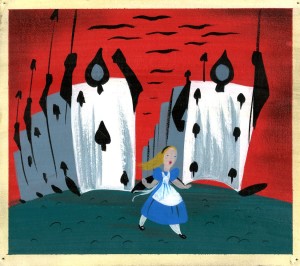 |
| Hearts of Tarts? One author’s (Donald Duck’s) solution to the nonsensical Alice in Wonderland. Mary Blair art featuring the Evil Queen’s henchman cards…who are to keep Alice away from her beloved prince. Huh? Read further. And for the most comprehensive history of Alice in Wonderland, well, anywhere, check out my good friend’s (hey!) website (also the source for this art) at: Alice in Wonderland |
ALICE IN WONDERLAND
A Solution To The Story Problem?
by Paul F. Anderson
So you think you know Alice in Wonderland? Are you familiar with Alice’s beloved prince? You know, the prince that Alice saved at the last minute from the evil Queen (no not Snow White’s Evil Queen, Alice’s Evil Queen!)? Remember, the prince that was being unjustly persecuted at the Evil Queen’s trial!? Surely you remember now, the prince that proclaimed to Alice (after being saved) that: “I’d rather have your heart than all the tarts in the world”?
Yes. Dear Reader, something is definitely off here! This is not the Alice in Wonderland you remember–either from the book or the Walt Disney animated feature–is it? Yet, it was a version that was proposed at Disney (apparently by Donald Duck–I’m not kidding!). Indeed, it all sounds pretty nonsensical, does it not? Just like Lewis Carroll’s masterpiece! Well, if you want all of this to somehow make sense, then read on!
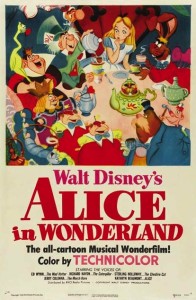 |
| Original 1951 Alice in Wonderland one-sheet from National Screen Service. Courtesy of the BEST site on the planet for exploring Walt Disney’s Alice in Wonderland, and run by my super good friend Matt Crandall. Check it out at: Vintage Alice in Wonderland |
The ever-present problems with the Alice in Wonderland story are well documented in Disney history. Indeed, even from the very beginning of Carroll’s Alice at Disney (not Walt’s Alice–confusing, I know), there were troubles with the story.
Walt first began to think about the literary property as a project for his studio in the early 1930s. It took on a more serious nature on June 2, 1932 when Walt inquired of the Fulton Brylawski law offices of Washington, D.C. about the copyright situation for Alice in Wonderland under English law. Walt was pleased with what he learned, for in a June 6th follow up letter Brylawski wrote: “In the present instance the longer term of copyright was for forty-two years from the date of publication, which term expired in 1911 and this book is now in the public domain.” More good news followed, as Walt discovered that Alice had never been protected by copyright in the United States. Walt was free to use the book as he wished; or so he thought!
Less than a year later Walt found another person in Hollywood that was equally enamored with Alice in Wonderland and wanted to do something with the story; it was none other than “America’s Sweetheart” Mary Pickford. It seems that Pickford may have first approached Walt and expressed her interest in a joint Alice project. Not long after Walt met with Mary in April of 1933 to discuss the notion. It was in this meeting that the pair discovered that not everyone shared their love of the book, because many Hollywood types thought the story too discombobulated. In fact, many were just downright opposed to Alice in general. “Despite the apparent lack of enthusiasm of certain members of my organization and the seeming hesitancy on the part of your business advisors,” wrote Pickford to Walt on April 19th, “my belief in the ultimate success, I might even say triumph, of ALICE has never wavered.” The two agreed that “capable business men” should not be expected to have the “artistic vision” that creative-minded people have; and so despite numerous objections from both camps, Disney and Pickford decided to move forward with their dream of realizing Lewis Carroll’s book.
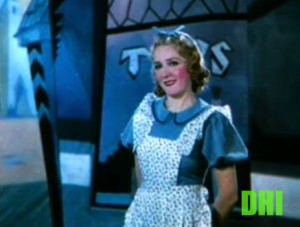 |
| A Technicolor still from the Walt Disney and Mary Pickford Alice in Wonderland collaboration. It is all that survives from the Technicolor test reel shot by Disney. |
Over the objections of his business people, Walt wrote to Pickford a little over a week later, expressing his desire to “whole-heartedly” move forward, but before he was to “work myself up into an enthusiasm which would lead to great disappointment should the deal fall through.” Before going any further, Walt wanted a “mutual business arrangement.” He closed with a typical Walt flourish that showcased his confidence in the project: “I sincerely believe that a Pickford-Disney production of Alice would be a sensation.” Walt was aware of the difficulties of the story (how could he not be, with that brilliant and agile story mind he had?), and before continuing he wanted a firm foundation with Pickford. Sadly, it never progressed to that stage because of copyright complications arising from Paramount’s claim that they had already bought the property outright in England. All that survives is a Technicolor test shot, and even that does not really survive (just a small piece).
Yet Alice stayed with Walt and from time to time he would address the potential issues with the story and continuity in an effort to devise a strategy on how to proceed with, what was in essence, a nonsensical narrative. Even into the 1940s Walt and his Story Department continued to gather treatments and ideas from people in the hopes of finding just one with “virtue” and “possibilities.” Hal Adelquist who had the duties of running the Story Department from time to time during the 1940s routinely sought out treatments. One such treatment came from a popular author that was cresting at the time–this author was a bit of a one-hit wonder. The best-selling book was “The Happy Time” and the author was Robert Fontaine. The 1945 novel had arrived at an opportune time when most were looking forward and trying to forget the horrors of World War II; the book was composed of a series of short stories about the author’s childhood in a French-Canadian village; so popular it was at the time, that it was already being turned into a Broadway musical (which turned into a staple of high-school drama productions for several decades), and many Hollywood studios had expressed interest. It did ultimately become a film in 1952 that featured a few Disney connections (it was directed by Richard Fleischer and starred Bobby Driscoll).
Adelquist kept an active eye on such things and as “The Happy Time” was flaring up the charts the Disney Story Department contacted Fontaine and his agent in October of 1945 to see if the author might have any ideas about Alice in Wonderland. Surprisingly the author, who then was quite busy with the dramatization of The Happy Time musical, sent a story treatment that was “strictly off the cuff.” Even with that, some in the Story Department thought it had high possibilities.
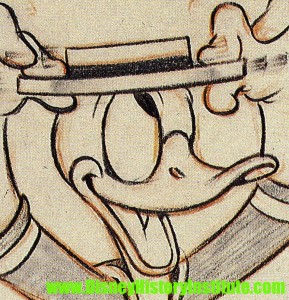 |
| The author!? |
On October 18, 1945 Fontaine wrote to Disney that he believed his idea about Alice might “preserve its internal nonsense … [and] … traditional nonsense” and might also at the same time “give it a simple plot…almost a romantic plot” (the latter of which he thought was similar to Snow White). His basic premise was that “nonsense dramatized needs some REASON” .. that the real trouble with Alice “has always been that there was no suspense because everything happened so aimlessly.”
So here at the Institute we present Mr. Fontaine’s treatment … a treatment we might add that in keeping with the nonsensical nature of the property he was writing about…Mr. Fontaine closed his idea with “I have spoken, Donald Duck.”
“We open with Alice playing Solitaire on the bank…she gets sleepy…blinks..yawns…picks up the Knave of Hearts..smiles..starts talking about how he is her favorite..so handsome…falls asleep…knave of hearts (and friend white rabbit) tell Alice he is an enchanted prince..turned into a playing card by a group of playing cards led by King and Queen of hearts..who having lost an actual Knave of hearts transformed him by magic…he has almost managed to overthrow the spell but now he has been falsely accused of stealing the Queens tarts and will be brought to trial and undoubtedly executed because the queen manages to get everybody executed…he tells her where the trial is…then is whisked away by some magic means..to a cell…Alice begins the hunt to get to the trial to save him….from then on we have the actual wonderland story but instead of it all being sheer nonsense it is a scheme of the Queen of Hearts to befuddle, confuse, frighten and delay Alice…or cause her to turn home in confusion and fear…Alice however arrives at the trial (as per book) and continues along book lines until she says “You’re only a pack of cards”… when they all turn back to playing cards EXCEPT the Knave of hearts who turns into a real, shining prince. “I’d rather have your heart than all the tarts in the world”..or something…only he starts shrinking back to a playing card as Alice wakes up with the knave of hearts clutched to her bosom and she muses that when she gets big he’ll come back.”

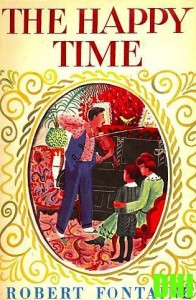
Absolutely fascinating!
Having done my own researches into Disney’s Alice while working on my edition of Carroll’s text with David Hall’s illustrations, I thought I knew most of the complex twists and turns in Alice’s labyrinthine journey from page to screen. But this was new to me…
So, very many thanks for sharing.
Thank you Brian. Coming from you, this is a truly amazing compliment. It does make one wonder how many other Alice “twists and turns” are still out there lost in the woods.
Very interesting post!
But it makes me think how Disney was not interested in imposing generic story lines on his adaptations. It seems he preferred to have the story grow organically out of incidents from the original. I think he knew that trying to add other elements would alienate an audience familiar with the original (after all – the point of adapting a classic was to have a ready audience) and would just feel “false”.